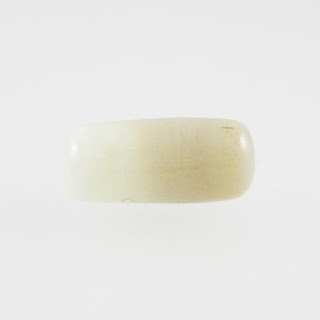1 - Plain (reduced), 2 - Plain, 3 - Ecru dots over Clear and encased, 4 - w/ Silver Leaf, 5 - w/ Silver Leaf (reduced & encased), 6 - w/ Silver Glass Frit (reduced), 7 - w/ TerraNova2 Frit, 8 & 9 - w/ Tuxedo, Copper Green, Opal Yellow, Ivory, and Peace
CiM Ecru is one of the newer CiM colours, and I am a fan. It melts beautifully, and none of my rods were in the least shocky. It fills a much-needed spot in my palette, there not being much in the way of semi-opaque neutral colours that aren't a nightmare to use in 104.
I intentionally tested this colour directly after testing Ivory Alabastro so that I would have a basis for comparison, and the results showed me that the colours are very different. The first major difference is workability. Ecru won this battle hands down, refusing to boil, shock, or splinter as I melted it. Second, the reactions I got with Ecru were quite different to what I found with Ivory Alabastro. Rather than describe the differences, I encourage you to go look at those results, which are in the post directly before this one.
The left side of this bead is Effetre Ivory Alabastro, and the right half of the bead is CiM Ecru. You can see here that Ecru is a bit warmer and a bit darker than Ivory Alabastro.
In this close-up of the smallest beads, what I see is that reducing Ecru hasn't changed it at all, and that pinkish brown webbing is evident in the surface of Ecru, although only at this magnification. I can't see it at all in these beads when I'm not wearing my magnifiers. In the right-most bead, I made a small core of Clear, added Ecru dots, and then encased the bead with Clear. What I learned here is that Ecru is so transparent in thin layers that you can barely see it. In person, it is only slightly more evident.
The addition of silver browns Ecru up considerably. You can see in the leftmost bead how it's gone a beautiful warm caramel colour. When the silver is reduced and encased, it results in a pinkish/blueish mottled appearance under the clear that has a faint MoP gleam to it.
Here in the leftmost bead, you can see that the 'caramelization' of Ecru also happens when you reduce silver glass on it.
When Copper Green is used on top of Ecru, it separates AND develops a dark line reaction around the dots and stringer lines. When Ecru is used on top of Copper Green, it separates the Copper Green slightly (the pale line around the Ecru stringer lines) but for some reason, no dark line develops.
Opal Yellow separates on top of Ecru. On top of Opal Yellow, Ecru spreads and feathers out, making its edges look all fuzzy.
Ivory separates on top of Ecru.
Sadly, due to my sad lack of photography skills, anything that might be interesting in the rightmost side of the rightmost bead has been lost to you, but you are not missing much because there's not a lot to see there. Ecru behaves with Peace much as it does with Opal Yellow, only less so, and less visibly since there's less contrast between the colours. And you can't really see Ecru very well on top of Ivory.
I made these spacers from a cane that was constructed similarly to the one I made with Ivory Alabastro, using the same other colours, and the result was that these beads came out a bit more uniform in colour and more translucent than the similar set made with the Ivory Alabastro.
Here are some fun beads with Ecru:










No comments:
Post a Comment